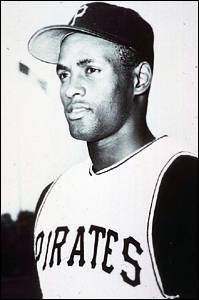

By Larry Schwartz
Special to ESPN.com
Playing in an era dominated by the likes of Willie Mays, Mickey Mantle and Hank Aaron, Roberto Clemente was usually overlooked by fans discussing great baseball players. Not until late in his 18-year career did the public appreciate the talents of the 12-time All-Star of the Pittsburgh Pirates.
Of all Clemente's skills, his best tool was his right arm. From right field, he unleashed lasers. He set a record by leading the National League in assists five seasons. He probably would have led even more times but opponents learned it wasn't wise to run on Clemente. Combined with his arm, his ability to track down fly balls earned him Gold Gloves the last 12 years of his career.
 | |
| Roberto Clemente's life was cut short when he died at age 38 in a plane crash. |
"He had about him a touch of royalty," then-commissioner Bowie Kuhn said.
Clemente was born Aug. 18, 1934, in Carolina, Puerto Rico, the youngest of seven children. Growing up he helped his father, who worked as a foreman on a sugar plantation and manager of a grocery store, load and unload trucks.
Clemente took advantage of the weather in Puerto Rico to play baseball year-round. He became consumed with the game. He squeezed a rubber ball to build up his throwing arm. While in high school, he signed a $60-a-month contract -- he also received a $5,000 bonus and a new glove -- to play for Santurce, a professional team in the Puerto Rican league. Clemente, then 18, hit .356 in the winter of 1952-53.
The next season, Brooklyn Dodgers scout Al Campanis held a clinic, and Clemente impressed Campanis enough that he offered him a $10,000 bonus. The teenager had to wait until he graduated from high school before he could sign with a major league team, but he gave his word to Campanis that he would sign with the Dodgers. Other teams later were ready to offer Clemente more money, with the Milwaukee Braves willing to give him a $30,000 bonus. But being a man of his word, Clemente stuck to his agreement and signed with Brooklyn.
 |
|
| Previous poll results |
Though only 20 and still learning the English language, Clemente became a starter for the Pirates in 1955. He wasn't an instant hit, batting .255 with five homers in 124 games. The next year, he hit .311. Two years later, he recorded 22 assists, tops among outfielders.
The Pirates, who were awful in Clemente's first three seasons, gradually built a strong club. In 1960 they won the National League pennant, with Clemente hitting .314 with 16 homers and a team-high 94 RBI and making his first All-Star team. He continued his stellar play in the World Series, hitting .310 as the Pirates defeated the New York Yankees on Bill Mazeroski's famous ninth-inning homer in Game 7.
But Clemente never wore his 1960 championship ring. Feeling snubbed by the writers because he only finished eighth in MVP balloting (teammate Dick Groat won the award), he wore an All-Star ring instead.
Clemente's performance in 1960 acted as a springboard for a terrific 1961. Physically, Clemente was in the best shape of his life, finally getting over the chronic back problems that had bothered him since his rookie season. With his improved health, Clemente hit .351 to win his first batting title, rapping out 201 hits.
From 1964 through 1967, Clemente won three more batting titles. And in the year he didn't win one, he was voted the National League's MVP. His averages were .339 (1964), .329 (1965) and a career-best .357 (1967). When he won the MVP (over Sandy Koufax, who went 27-9 with a 1.73 ERA and trailed by 10 points in the voting), he finished fifth in batting at .317 but had career-highs with 29 homers and 119 RBI (second best in the league). The Pirates came in third, three games behind the first-place Dodgers.
In 1971, Clemente (.341) and Willie Stargell (48 homers and 125 RBI) led the Pirates to another pennant. Though one of the game's finest players, Clemente hadn't received much national media attention. That changed in the World Series when he became a one-man wrecking crew against the Baltimore Orioles, chasing down fly balls, unleashing marvelous throws at every opportunity and blistering pitchers to a .414 tune. His home run in Game 7 provided the Pirates with their first run in a 2-1 victory. He was voted the Series MVP.
In 1972, at the age of 38, he batted .312, though injuries limited him to a career-low 378 at-bats. On Sept. 30, Clemente doubled off New York Mets left-hander Jon Matlack. It was his 3,000th hit. Nobody knew it at the time, but it would be his last regular-season hit (he had four in the Pirates' loss to Cincinnati in the playoffs).
During the winter of 1972, Clemente began work on a sports city for the young people of San Juan. But on Dec. 23, the city of Managua, Nicaragua, was rocked by an earthquake that killed thousands, and left many more homeless. Clemente worked organizing a relief effort for the quake victims. On New Year's Eve, Clemente and four others boarded a small DC-7 loaded with supplies for the victims. Shortly after takeoff, the plane exploded and crashed in the Atlantic Ocean. There were no survivors.
Clemente's death shocked the world as well as the people of Puerto Rico, where a three-day mourning period was declared. The Baseball Writers Association of America held a special election and the mandatory five-year waiting period for the Hall of Fame was waived. On Aug. 6, 1973, Clemente, who had a lifetime .317 average with 240 homers and 1,305 RBI, was posthumously inducted into the Hall. He was the first Hispanic elected to the shrine.
In memory of Clemente, the player and humanitarian, the Pirates in 1973 wore uniform patches with his No. 21 on them.

